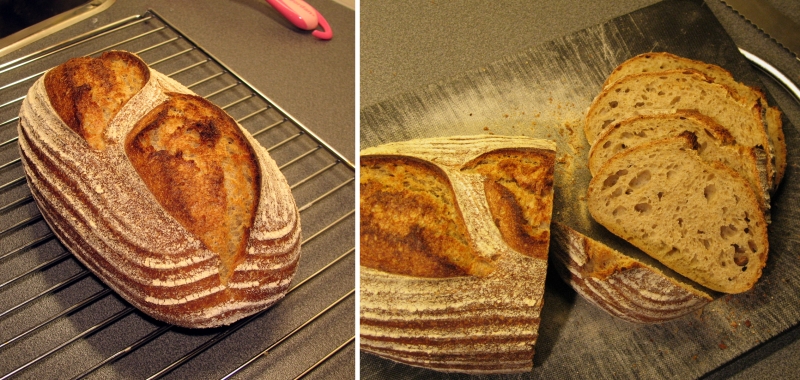hansjoakim's blog
Busy bakes
The last few weeks have been really busy, as I've been preparing my thesis defense, and as a result, my once spoiled starter has faced long, dreary days in the unforgiving cold of the fridge. After three weeks of neglect, it didn't look too perky to tell you the truth. After completing the hardship, I pulled it out four days ago, and started nursing it with nice, cosy, warm water, fresh AP flour and liberal sprinklings of rye flour. It bounced back and took to its old self within a day, so either its short-term memory is pretty bad, or I'm overtly concerned about its state of health...
Giving oatbread a twist
I was inspired by Eric's medieval bread and wanted to try something different with Hamelman's oatbread. I ended up with a medieval bread/Pain de Beaucaire hybrid... I first shaped two baguettes of the oatbread dough. The two vertical sides of the baguettes were brushed with water, and the outer edge dipped in rolled oats. The inner side was partly sprinkled with coarse rye flour, and the baguettes shaped as below:
Rustic crust and crumb
I remember rustic bread from "Bread" being a staple in my kitchen before I got started with levains and sourdough breads. It's a clean, wholesome bread, and it's over a year since I'd made his rustic bread, so the time was ripe for another attempt.
I wanted to try some different shapes as well, so I divided the dough in two, both weighing 750 gr. each. One was shaped as an ordinary batard, and the other piece was cut into smaller dough chunks, and shaped into mini-batards and the tabatiere and pain d'Aix shapes shown in ABAP.
Breakfast loaf and pastries
Jan Hedh, the Swedish bread, pastry and chocolate master, has recently put out his second bread book; the new one is titled "Bröd & kaffebröd" ("Bread and pastries"). I've just picked it up, and baked the first loaf from that book this weekend. It's an inspiring book, written in a style similar to his first bread book, but this one's filled with even more gorgeous photos. Hedh is passionate about bread, and provides detailed recipes for several European style hearth loaves and for breakfast pastries (mostly croissant, Danish and sweet dough oriented stuff).
Recent breads and two fruit desserts
Here are some of the breads baked over the last couple of weeks:
First is a pain au levain with whole-wheat (p. 160 in "Bread"):

The original formula is great and it's a very nice dough for practicing folding, shaping and different slashes. It's a pleasure to see the cuts open up and bloom during oven spring, and the subtle flavour works well with just about anything. One of my all-time favourite loaves that I keep making often!
Sourdough rye and sourdough rye with walnuts
The cover of "Bread" and plate 21 "Assorted Rye Breads from Chapter 6" depict a delicious, rustic looking rye bread that's not slashed. I love the look of this dark, "lava rock" with deep fissures running in random lines along the top of the bread. I wanted to bake a loaf with similar cracks on top, so I prepared the dough for my favourite 70% rye. I'm using medium rye flour, and pre-ferment half of the rye in a sourdough. The remaining 30% is AP flour. I do not put any commercial yeast in this one, so it's important that the rye sourdough is ripe before mixing the final dough.